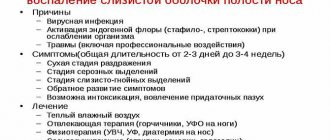Purulent nasal discharge in a child is a fairly common phenomenon and is called purulent rhinitis or sinusitis. There are several types of this pathology and the reasons for its occurrence. Depending on what caused the health problem, treatment is carried out with medication or surgery. Self-medication for this pathology is extremely dangerous, as it can easily provoke severe complications of the disease and even cause death. You should seek the help of a specialist as soon as the first symptoms of a child’s condition appear.
A purulent process develops if a bacterial infection of the nasal mucosa occurs. Quite often, this phenomenon turns out to be a secondary infection, which begins 3-5 days after acute viral rhinitis develops. In this case, the child’s condition worsens sharply, and the nature of the mucus changes. In order for infection to occur, provoking factors must be present. Because of this, not every viral rhinitis ends in the development of a purulent process. Often, clear discharge appears from the baby's nose, which then completely disappears without turning purulent.
Treatment of a purulent runny nose in a child is a long process, and parents should approach it seriously. In most cases, antibiotics cannot be avoided. The drug must be selected by a doctor after the causative agent of the inflammatory process has been identified.
The problem of purulent snot is most common among children under 8 years of age, which is due to the structural features of their upper respiratory system. At the same time, even at an older age it is impossible to completely protect against the occurrence of a disorder. Most often in this case, sinusitis occurs.
Why does pus occur?
The appearance of pus from the nose is associated with the activity of pathogenic bacteria, which secrete certain toxins by processing the mucus that accumulates in the paranasal sinuses during rhinitis. As a result of this, a special process of decay begins, due to which the mucus becomes pus and, with sufficient lumen in the sinuses, begins to be released from the nasal passage.
It is impossible to confuse pus with snot, which appears in the case of a common runny nose. Purulent mucus has a green or yellow color and a repulsive, pungent odor. Also, purulent discharge is characterized by increased density and often includes lumps of a more intense color.
In rare cases, blood is mixed with pus. This is due to the fact that in the mucous membrane, against the background of inflammation and the activity of pathogenic bacteria, a pathological process occurs, which leads to its deformation and damage. As a result, the disease easily becomes chronic if left untreated.
Symptoms of chronic runny nose in adults and children
Despite the fact that symptoms of chronic runny nose in adults are observed all year round, during the course of the disease there are periods of exacerbation and remission. During the period of remission, the signs of the disease subside, and during exacerbation they rapidly manifest themselves.
The most characteristic symptoms of chronic runny nose3:
During remission, nasal congestion decreases, but dry, painful crusts appear in the lumen, which bring significant discomfort when breathing.
Symptoms of chronic runny nose in children during an exacerbation are especially acute. It becomes impossible for children to breathe normally, often accompanied by a cough and sore throat. In severe cases, the disease can provoke laryngeal stenosis, a dangerous complication in which airway patency sharply deteriorates3.
A long-term runny nose can lead to the formation of polyp-like growths in the nasal passages. They close the lumen of the nose, which greatly complicates conservative treatment. Due to impaired outflow from the maxillary sinuses, sinusitis often develops - inflammation of the paranasal sinuses. During periods of pronounced pathogen activity and with weakened immunity, infection from the inflamed sinuses can penetrate the brain. As a result, meningitis occurs - an inflammatory process in the lining of the brain3.
Do not confuse a runny nose with sinusitis - inflammation of the paranasal sinuses. The diseases are different, but sometimes they occur simultaneously due to weakened immunity. With this option, it is necessary to restore immunity as quickly as possible and defeat all provoking infections, most often ARVI.
Causes
A purulent process can occur only due to damage by pathogenic bacteria. If they are absent, then suppuration will not develop. As a secondary infection, bacterial damage can occur due to exposure to allergens, fungi or viruses. Most often, purulent discharge is observed precisely with initially viral rhinitis. They can occur when the following diseases are present:
- Frontal sinusitis is inflammation of the frontal sinus mucosa. With this disease, the child suffers from particularly severe headaches and an unbearable feeling of pressure and fullness in the forehead;
- ethmoiditis - inflammation of the mucous membrane of the ethmoid labyrinth. The disease manifests itself clearly and, in addition to the discharge of pus, there is swelling of the eyes, pain around them and often especially severe between them. Also, in most cases, there is a partial loss of smell and nasal congestion;
- sinusitis - inflammation of the maxillary paranasal sinuses. Purulent mucus is most often green in color, and the unpleasant odor that comes from it is also felt from the child’s mouth. The child complains of very severe pain in the cheeks, under gases and in the area of the roots of the upper teeth. Headache, severe and greatly aggravated when the patient bends forward. The temperature and weakness of a sick child are elevated;
- sphenoiditis - inflammation occurs in the sphenoid sinuses of the nose. In children, this disease develops quite rarely and causes severe pain in the neck, ears and top of the head. The patient's health seriously deteriorates;
- purulent rhinitis - develops due to bacterial irritation of the mucous membrane of the nasal passages. The snot is yellow-green in color. They are constantly released in large volumes and lead to skin irritation in the area under the nose. It becomes painful, often covered with cracks and dry crusts.
Disease provoking factors are various reasons that affect the child’s immunity, leading to its decrease. The main ones are:
- severe hypothermia;
- stress – it can be associated with various events in a child’s life, including the start of kindergarten or school;
- frequent nose picking - with this action, the mucous membrane is regularly injured and bacteria can penetrate the tissues, bypassing the immune barrier;
- the presence of polyps or proliferation of adenoid tissue;
- chronic inflammatory diseases of the throat or nose;
- non-compliance with medical recommendations after vaccinations;
- poor nutrition, in which the child does not receive enough vitamins and minerals;
- violation of nasal hygiene rules;
- excessive dryness of indoor air.
In some cases, the cause of purulent discharge with a particularly foul odor is a runny nose. This is an atrophic form of rhinitis, which requires particularly serious treatment.
Prolonged runny nose in a child: treatment and elimination of symptoms
How to treat a persistent runny nose in a child? Depending on the type of persistent runny nose in a child, the methods of treating it vary.
Allergic rhinitis
Parents should know that allergic rhinitis can only be eliminated by getting rid of its cause. To relieve allergy symptoms, there are antihistamines that are given to the child only as prescribed and under the supervision of the attending physician.
In the fight against an allergic reaction and chronic rhinitis, it is important:
- Prevent dust from appearing in the child’s room and frequently carry out wet cleaning;
- Constantly humidify the air in the room. If the cause of a prolonged runny nose is a fungus or mite, high humidity prevents their reproduction;
- Use only special gentle household chemicals;
- If pillows and blankets are made from natural feathers or down, they should be replaced with bedding made from synthetic hypoallergenic materials.
Bacterial and viral rhinitis
Bacterial and viral persistent runny nose requires a serious approach to its treatment. After determining the diagnosis, the pediatrician will prescribe medications and drugs appropriate for the child’s age.
To eliminate the symptoms of prolonged rhinitis, drops and sprays are usually prescribed, which are sprayed several times a day into the child’s nose.
There are several types of drugs for the treatment of prolonged rhinitis.
Medicines that contribute to the narrowing of blood vessels in the mucous membrane:
- Nazol.
- Otrivin.
- Vibrocil.
- Nazivin.
The principle of operation of these drugs is a certain effect on the blood vessels, which causes them to narrow and reduce the amount of mucus released.
Important! It should be noted that these medications are intended to relieve symptoms but do not eliminate the cause of a persistent runny nose. They are used no more than three times a day for 5-7 days.
Pediatricians often prescribe homeopathic remedies based on natural ingredients. They have an anti-inflammatory and healing effect and effectively kill microbes.
The drug Delufen has a gentle effect on the mucous membrane of the child’s nose, eliminating the symptoms of a prolonged runny nose. Sulfacyl-Sodium eye drops to be dripped into the nose ; this is an antimicrobial agent that can completely extinguish the focus of bacterial rhinitis in a few days.
- It’s easy to overcome a long runny nose in adults: find out how to do it
Euphorbium nasal spray is prescribed not only for the treatment of chronic rhinitis, but also for the prevention of exacerbation of colds.
Tablets and syrups also help treat persistent runny nose. Homeopathic medicines Sinupred and Cinnabsin are used orally as prescribed by a doctor as an adjuvant for chronic rhinitis.
In the case of bacterial rhinitis, drugs such as Isofra (for children from the age of two) and Polydexa (prescribed only from the age of six) are effective. These medications contain antibiotics that kill various types of bacteria. The duration of treatment and dosage are prescribed by the pediatrician.
Why is there blood mixed in?
The admixture of blood in a child’s purulent snot especially frightens parents. In this situation, the mucus turns brown. There are many reasons for this phenomenon. Most often it is observed due to the development of changes in the mucous membrane of the paranasal sinus. There are also the following factors causing the violation:
- formation of a boil in the nasal passage;
- excessively intense nose blowing;
- malignant neoplasms in the nasal cavity.
Only a doctor can determine exactly what caused purulent discharge with blood from the nose in a child after an examination.
Causes of a runny nose
Depending on the nature of the pathogen, a runny nose can be viral or bacterial. Allergic rhinitis occurs when a person comes into contact with an allergen. Another type of rhinitis - neurovegetative - is associated with disruption of the blood vessels of the nasal mucosa.
The following reasons can provoke constant discharge from the nasal cavity of different colors and nature:
- allergic reaction to an irritant (wool, dust, household chemicals, perfume smell, etc.);
- infection with viruses, bacteria and fungi;
- adenoids;
- hypothermia;
- decreased immunity;
- mechanical injuries of the nose;
- constant use of certain medications;
- hormonal changes in the body;
- spicy food;
- dusty, polluted air;
- neoplasms in the nasal cavity.
Each of the reasons has its own mucus character.
Forecast
The prognosis for the patient, if treatment is started in a timely manner, is positive, since the purulent process in such a situation can be completely eliminated. If for some reason the child did not receive treatment before complications developed, then, depending on which of them occur, the prognosis will be from unfavorable to poor. The intracranial consequences of purulent nasal discharge are especially dangerous. They lead to severe brain damage, which causes disturbances in the development of the child, and sometimes turn out to be incompatible with life.
What is snot?
Snot is a constant discharge from the nose produced by its mucous membrane. Their main task is to protect the organs of the respiratory system from pathogenic microorganisms entering them and remove them from the nasal cavity to the outside. Both sick people and healthy people have snot. The only difference is in their abundance and the nature of the mucus. Up to 500 milliliters of mucus are secreted per day - we do not notice this process, since most of the mucous mass flows down the nasopharynx and is swallowed. Already in the stomach, foreign particles and microorganisms that “stick” to the nasal mucus are destroyed under the action of gastric juice.
The composition of mucous secretions in the nose is absolutely harmless: it is a special protein mucin, water, salts, enzymes. Mucin gives the discharge a viscous character. If the snot is not viscous (in everyday life we say “like water”), this means that the body is experiencing a lack of protein.
Thus, snot is a permanent natural barrier, the purpose of which is to intercept foreign particles and pathogenic microflora and prevent their further penetration into the lower respiratory tract.









